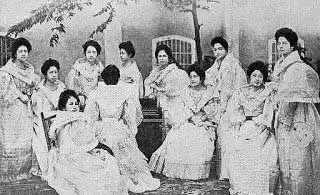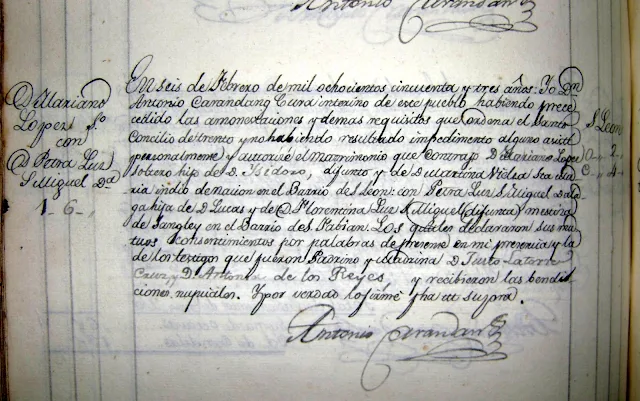Narciso Claveria’s 1849 Decree and the Surnames of the People of Lipa
In the early days of the Spanish colonial era in the Philippines, as the indios or native Filipinos converted to Christianity, many such natives also started taking on Spanish names: of Catholic saints, symbols, sacraments and feasts and even the names of Popes. There was, as yet, no definitive system for administrative purposes so that it was not uncommon for native Filipinos to take two or three names and change these whenever it took their fancy.
Neither were uniform surnames for members of the same family required, so that siblings would often have different surnames. In practical terms, this was a nightmare for the church and the bureaucracy. Inheritances were difficult to prove and it was difficult to ascertain if couples asking to be wed were close relations or not1.
The Spaniards being what they were, it was not until the 19th century that something was actually done about what was an obvious administrative problem. In 1849, the Spanish Governor-General Narciso Claveria, an officer in the Spanish army, issued a decree requiring native Filipinos to all have surnames. A catalogue of Spanish and local surnames were sent out to towns all over the country; and from these those who did not have surnames were either issued these or obligated to choose from the catalogue2.
 |
| Women of the Red Cross Society of Lipa, early 1900s. Image source: “The Story of the Lopez Family: A Page from the History of the War in the Philippines.” |
This was part of a process of creating a national civil registry. Because the decree was intended to address administrative problems, “rules were established so that Filipino families would all have consistent surnames3.” Although the bulk of the surnames provided by the catalogue were Spanish, there were also others taken from local languages such as Tagalog, Ilocano, Hiligaynon, Cebuano, Kapangpangan and Pangasinense. There were also Hispanized Chinese names4.
Under the system implemented, a surname could only be claimed by one family per municipality. In some cases, many families of the same town all took surnames beginning with the same letters. For instance, in Nasugbu, many family names began with the letter “V.”
There were also exemptions: families with existing surnames already in the catalogue or those not in the prohibited list of surnames – for being too common or for being associated with an ethnic background. Some families with surnames in the prohibited list could keep their surnames insofar as they could prove that they had used the surname for at least four consecutive generations5.
To see a practical application of Claveria’s decree, let us examine the case of some families of the then-town of Lipa in Batangas who were obligated to adopt new surnames – as well as a few who were allowed to keep theirs, for reasons already explained. The sampling below was compiled by Lipa and Batangas historian Renz Marion D. Katigbak, with the first column being the old surname and the second being the new surnames. His source for these samples was the Registros Parroquiales of Lipa, 1850-1855.
| PREVIOUS NAME | NEW CATALOGUE NAME |
|
Adriano Alejandro Alfonso Alipio Ambrocio Andres Antonio Bartolome Benito Bernardo Carpio Cornelio Crisostomo Cristobal |
Robico/Rubico Lata, Luceño, Rocafort, Tisico, Poliquit Lanto Llaga Lipat Letrero, Piris Lipit, Maño, Perejil, Talao Lescano Laco Lara, Lasig, Loisaga, Mojares, Padurra, Virrey Laluces, Olais Leyco, Perjes Balinis Pescal |
| De la Cruz | Albis, Balual, Basilla, Cadelmo, Cirujano, Hoseña, Laciano, Lalapos, Lalusin, Laigo (Laygo), Latoc, Logtu, Lubrica, Lucido, Labiste, Libalig, Libon, Librea, Libut, Lingao, Lolab, Loma, Lubid, Lucillo, Mabitag, Magabo, Magaling, Magsusi, Maguinoo, Malleta, Mestas, Mojado, Morcilla, Morden, Mosca, Nagboo, Nario, Nodera, Obcial/Obtial, Olan, Olap, Onira, Padro, Paran, Payag, Pedraja, Peremne, Perile, Perilla, Posag, Prado, Quiza, Recon, Refran, Resaba, Resma, Riglos, Robledo, Rocamora, Roceta (Rosita), Rodelas, Royeca, Sabido, Saldua, Saludo, Serojo, Serra,, Solot, Tacla, Temple, Teñoso, Tictic, Torre, Verso, Viñas, Ysaga (Isaga) |
| De Leon | Aguirre, Lina, Litan, Marzo, Recinto, Tisbe, Tuero |
| De Los Santos | Carrapati, Honrade (Onrade), Laclac, Lacorte, Lacteo, Laidea/Laydia, Lalang, Lalamonan, Lantin (Lanting), Latac, Latade, Latina, Latoja, Latuno, Laudis, Lequi, Let, Leus, Libiran, Libuit, Lindo, Lipio, Lislis, LLanes, Lubigan, Lucillo, Magdolot, Magpili, Magtundo, Maray, Marfori, Mayor, Mexico, Moren, Olano, Olbeda, Onte, Ontog, Orosco, Padilla, Paison, Parco, Pesa, Pisano, Posablem, Roblisa, Rubion, Saul, Saus, Tapat, Tubigan, Viaje |
|
Domingo Donato Eleno Estacio Estanislao Enrico Francisco Fulgencio Germino Gabino Geronimo Gregorio Hermenegildo Ignacio Jacinto Joaquin Lazaro Lorenzo Lucas Manuel Marcelino Marcelo Mariano Martin Matias Pablo Padua Paulino Ramos Regino Roberto Salvador San Agustin San Gabriel San Luis San Jose San Juan San Miguel San Nicolas Santa Ana Santa Ynes Santiago Santo Niño Sebastian Silvestre Simeon Tadeo Tiburcio Urbano Valentin Ventura Ysidro |
Rojales Mancio Lubian Arante, Quinita Tividad Ona Mando Lalunio, Lasig Lolog Latayan Icaro/Ycaro Mayol Leyesa/Leyeza Olave, Poblico Landig Payo, Silam Latorre Las Linatoc, Lacay Verte Lomas Contilla, Pestelos Olgado Libita (Levita), Morada, Tornia Lacar, Teru Lindo, Tala Paulino Mision Laino, Naredo Garing Lirag Libita (Levita), Latag, Lagos, Subiel, Savillo, Paet Latosa Morfi (Morpi), Sureo, Tirado Liban Tiquio Libera, Lucero, Molata, Regil (Begil), Yamo Lasat, Olayao Restan Lajara, Loliña, Marave, Vilela Turino Letargo, Lupac, Sabili Alabastro, Lailo (Laylo) Pirit Luque, Nerja Lolon Pernez, Serios Martija Lumbera Lat, Tapalla Saus Nara |
| PREVIOUS NAME | NEW CATALOGUE NAME |
|
Cornelio (de la) Cruz (de) San Miguel Teodoro |
Recio Latorre, Mea/Mia, Mayo, Sales Luz, Metra/Mitra Recto, Templo |
- Africa
- Altamirano
- Briones
- Catigbac
- Calao
- De los Reyes
- De Mendoza
- De Silva
- De Torres
- Dimaano
- Dimayuga
- Dimaculangan
- Gonzales
- Lopez
- Macarandang
- Macasaet
- Magtibay
- Manguiat
- Mantuano
- Magcauas
- Mantuano
- Masongsong
- Maralit
- Panganiban
- Roxas
- Solis
- Zara
- Aranda
- Kison/Quizon
- Malabanan
- Ynciong/Inciong
2 “Narciso Clavería y Zaldúa,” Wikipedia.
3 Morrow, ibid.
4 “Catálogo alfabético de apellidos,” online at IPFS.
5 “Catálogo alfabético de apellidos,” Wikipedia.



